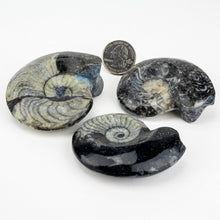
Goniatites evolved from nautiloids in the early Devoian period, about 400 million years ago. They were abundant in world seas for the next 370 million years, after which they vanished suddenly at the end of the Cretaceous period. The rapid evolution of ammonoid species and their widespread distribution make them of great value in the subdivision of Late Paleozoic and Mesozoic time. Ammonoidea sutures can be simple, or complex. Mineral exchange over the eons can create an amazing array of contrasting colors. Goniatite sutures include both pointed and rounded elements in the form of a zig-zag. The modern nautilus is the only surviving shelled cephalopod. From the modern nautilus we can learn much about the function of the shell of the extinct ammonites. Although there are many similarities between nautiloids and ammonites, it appears that ammonites had closer affinities to today's squids and octopi. Ammonites may have evolved from an ancient nautiloid more than 400 million years ago during the Silurian Period.









